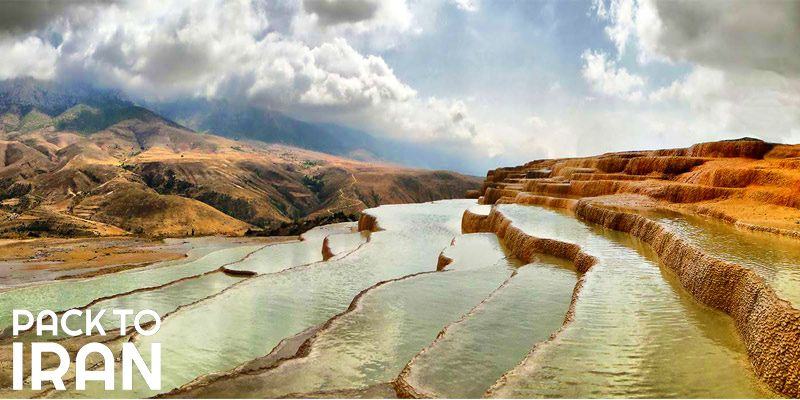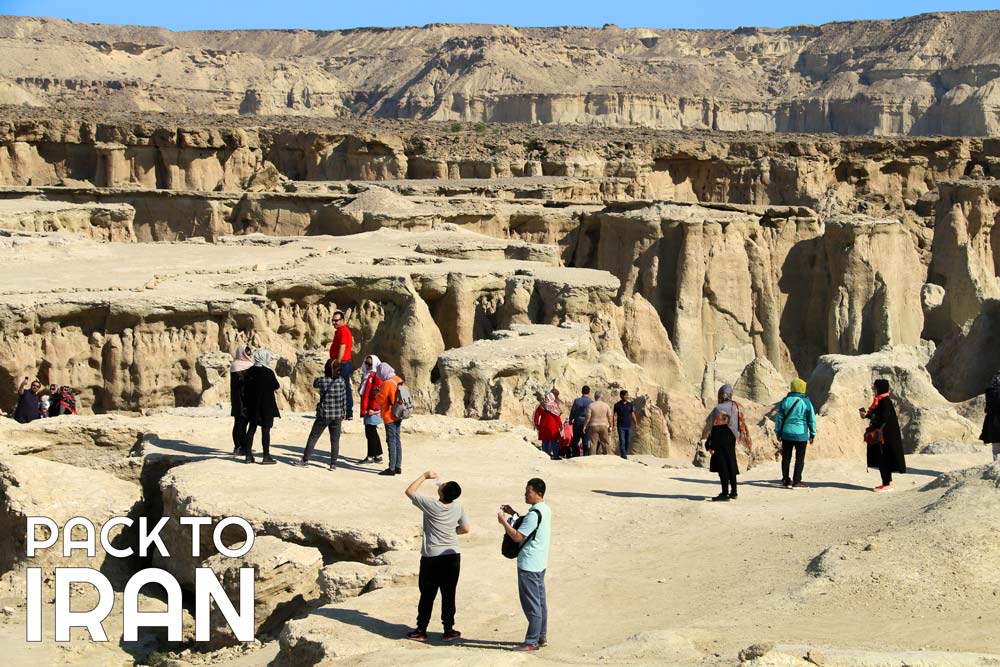Diversity in the geography and climate has resulted in many natural wonders in Iran, including calm beaches in the south, lush forests, over 4000-meter-peaks of Alburz and Zagros moutain ranges, and picturesque deserts in the center and east of Iran. The climate in Iran is so diverse that in a single day during winter you can ski in Dizin Resort in the north and then enjoy surfing under the sunlight by taking a flight to Chabahar Port. Also in one day during summer the temperature in Khuzestan reaches over 50 degrees centigrade, while on the heights of Alburz Mountains the weather is foggy and rainy with a temperature around 20. Today, nature activities are getting popular among foreign travelers in Iran and many travelers are planning on a second trip to Iran to explore the top natural wonders in this country. Also, many cultural Iran tours are getting combined with some nature adventures, to offer the best experience to travelers. Choosing among the natural wonders in Iran is so difficult but we have tried to introduce the top ones:
1- Qeshm Island
Located in the heart of the Persian Gulf in southern Iran, Qeshm Island is the largest island in Iran and is 120 kilometers in length and 10-35 kilometers in width and more than 60 villages where southern and Bandari life still goes on. Since this island is home to mind-blowing natural phenomena it has always been among the top nature wonders in Iran, however, it has remained undiscovered by most of the foreign travelers who know a little of natural wonders in Iran. Besides the very calm and untouched beaches where you can get relaxed, one of the most important attractions of Qeshm is the Hara (Mongrove) Forest which covers 226000 hectares of Qeshm Island northern shore is a biosphere reserve with unique characteristics and is a major habitat for migratory birds, fish, reptiles and other species. But what makes this island to be a standout, is the Qeshm Geopark which boasts a variety of geological formations, including stunning rock formations, towering cliffs, and breathtaking canyons. Since Qeshm has hot and humid weather, the best time of year for traveling to this island is in autumn and winter. Qeshm Island boasts unique beauty features that set it apart. With its stunning natural landscapes, including the mesmerizing and vibrant Valley of Stars, Qeshm Island offers a visual feast for visitors. Its pristine beaches, such as Naaz Islands and Chahkooh Canyon, showcase the island's diverse marine life and geological wonders. Qeshm Island's rich cultural heritage, traditional villages, and warm hospitality further enhance its unique beauty.
|
|
| Qeshm Island - Iran |
Also, watch a video of the mysterios Chahkooh Valley in Qeshm Island:
2- Lut Desert
Get ready to embark on an unforgettable journey to the heart of the Lut Desert, a natural wonder in Iran, that will leave you in awe. This vast desert in the southeast of Iran is a geological masterpiece, boasting a rich variety of phenomena that will take your breath away. Despite its reputation as one of the hottest and most inhospitable places on earth, the Lut Desert is a true oasis of beauty and wonder. To experience the most amazing parts of the Lut Desert, head to the enchanting city of Shahdad. Here, you will find some of the most incredible desert landforms, including the Yardangs/Kalouts. These stunning rock formations were created by the relentless force of wind erosion, resulting in otherworldly shapes and textures that are simply mesmerizing. Another must-see attraction in the Lut Desert is the Nebkhas, also known as desert vases. These dunes form around Tamarisk bushes, creating a unique and striking landscape that is both beautiful and fascinating. And when night falls, get ready for a truly magical experience. The Lut Desert is known for its amazing starry sky, which will leave you in awe of the universe's vastness and beauty. The best time to visit the Lut Desert is from February to early June and from October to November. So pack your bags, put on your adventure hat, and get ready to explore one of the most stunning natural wonders on earth with PackToIran team!
Interested in the Deserts and Shores of Iran? Check it out: Iran-Deserts-and-Shores-Tour and book right now!
|
|
| Lut Desert - Iran |
3- Badab Surt
Badab Surt or Badab-e Surt, located in the picturesque Mazandaran Province of northern Iran, is a breathtaking natural wonder in Iran that never fails to captivate visitors with its astonishing beauty. This enchanting site boasts twelve sparkling water springs, each possessing its own unique chemical composition. These springs, known as travertine water springs, have formed over thousands of years in a mesmerizing stepped pattern. The magic of Badab Surt lies in the interaction between the mineral-rich water and the surrounding environment. As the water flows down the terraces, it combines with various mineral substances, resulting in an array of vibrant colors. The sight of these springs adorned in hues of red, yellow, and other shades is truly a sight to behold and adds an extra layer of magnificence to the already stunning landscape. The geological processes at work in Badab Surt are nothing short of remarkable. Over time, layers upon layers of mineral deposits have accumulated, giving rise to these striking terraces. The combination of calcium carbonate and other minerals present in the water has contributed to the formation of these unique stepped structures. The tranquil ambiance further enhances the experience, allowing visitors to connect with nature on a deeper level. As one stands amidst this natural wonderland, it becomes evident why Badab Surt is considered one of Iran's most treasured gems. Its ethereal beauty serves as a reminder of nature's boundless creativity and leaves an indelible impression on all who have the privilege to witness it firsthand.
Interested in visiting Badab Surt and some other Natural Wonders in Iran: Check This Out and Book Right Now: North-of-Iran-Tour
|
|
| Badab Surt - Iran |
4- Damavand Mount
Damavand Mount, situated in the Alburz Mountain Range in the northern region of Iran, proudly stands as the highest peak in both Iran and the Middle East. Additionally, it holds the title of being the highest volcanic peak in Asia. This towering mountain, reaching a staggering height of 5670 meters, serves as a symbol of strength and stability for Iranians and has been immortalized in Persian legends and poetry. Beyond its cultural significance, Damavand Mount is a magnet for mountain climbers and adventurers from across the globe. The period between July and August witnesses a surge in visitors as this time offers ideal weather conditions for ascending to the summit. Aspiring climbers can choose from four different climbing routes: the northern flank, northeastern flank, western flank, and southern flank. Among these options, the southern flank stands out as not only the safest but also the most popular route. The allure of Damavand Mount lies not only in its impressive height but also in its breathtaking natural beauty. As climbers make their way up this majestic peak, they are treated to awe-inspiring vistas of rugged landscapes adorned with lush greenery. The journey to the summit is an arduous one that demands physical endurance and mental fortitude; however, it rewards those who persevere with an unparalleled sense of accomplishment. For those seeking adventure and a chance to conquer new heights both literally and metaphorically, Damavand Mount beckons with its majestic presence. It offers an opportunity to test one's limits while immersing oneself in Iran's rich cultural heritage.
|
|
| Damavand Mount - Iran |
5- Caspian Hyrcanian Forests
The Caspian Hyrcanian Mixed Forests is a vast area of lowland and mountainous forests that covers 55000 square kilometers on the northern face of Alburz Mountain Range and south of the Caspian Sea, which includes Northern Khurasan, Golestan, Mazandaran, Gilan, and Ardabil provinces. In lower lands, the climate is humid and subtropical while it gets humid continental in mountainous and higher lands. Some parts of this ancient forest have remained from 25-50 million years ago when broad-leaved forests covered most parts of the Northern Temperate region.
Hyrcanian forests have rare ancient flora like chestnut-leaved Oak, Persian Silk Tree, date-plums, and numerous types of bushes and shrubs and a very rich fauna species like Persian leopard, bear, red deer, golden jackal, jungle cat, otter, etc. The Caspian Hyrcanian Mixed Forests are a unique and diverse ecosystem found in Iran. They boast a rich biodiversity, with over 8,000 species of plants and animals, many of which are endemic. During spring and summer, when the weather is mild and suitable for forest hiking travelers and nature lovers take hiking trips in the heart of Hyrcanian forests in areas like the Abr Forest and Golestan National Park in Golestan Province, Alimastan Forest, and Chahar Bagh region in Mazandaran Province, and Gasht-e Rudkhan and Lisar in Gilan Province.
Interested in Visiting Caspian Hyrcanian Mixed Forests and Some Other Natural Wonders in Northern Iran?
Check This Out and Book Right Now: North-of-Iran-Tour
|
|
| Hyrcanian Forests - Iran |
Choose and Book a Tour with the PackToIran team and Visit Natural Wonders of Iran:
Mahan and Lut Shahdad Desert Adventure Tour







